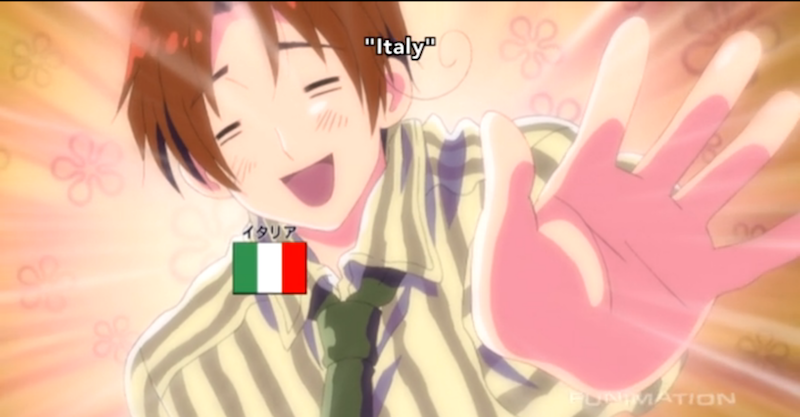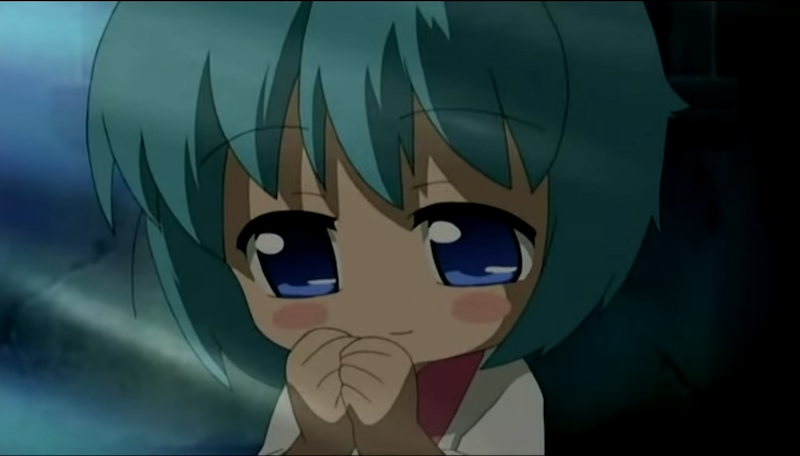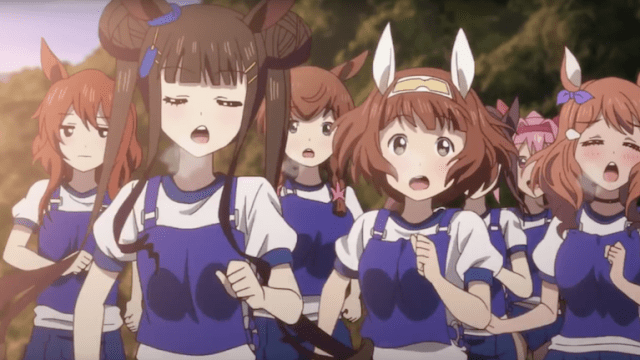Weird tropes find their way into anime, and I’m not just talking about tentacle porn. Judgment aside, cat girls, superpowered transfer students and Vespa-riding aliens are objectively a little eyebrow-raising as television plot hooks. To be an anime fan, you get used to things you wouldn’t normally poke with a five-foot pole. Regardless, I was completely unprepared for Uma Musume Pretty Derby, a “moe anthropomorphism” anime that, like others of its genre, portrays non-human subjects as megacute people.
Uma Musume
Uma Musume, translating to “horse daughter,” is an upcoming anime about teenaged girls who are also racehorses and musical idols. The preview opens as the girls escape a cage and excitedly launch into a foot race, their horse ears and tails trailing behind them.
Each has her own look — sullen with long hair, spritely and cat-eyed, for viewers to get attached to. J-pop plays in the background. In one moment, a horse-girl is catching her breath by a pool. In another, one’s sitting alone at dinner, stomach bloated with carrots, sighing cutely.
The girls are offputtingly compelling, their human characteristics over-emphasised despite the fact that they’re … horses.
What gives? Where did this come from?
Uma Musume is an extreme example of so-called “moe anthropomorphism,” an anime trope in which protagonists are non-human but possess exaggerated human qualities, especially of the adorable variety. Debra Occhi, a linguistic anthropologist at the Miyazaki International College, describes “moe characters” as “constellations of various cute traits that fans will find appealing to various degrees.”
In this sort of anime, computers, countries, animals and household objects have been drawn as super-adorable humans, all with big eyes, heart-melting expressions or youthful sexual appeal. The sort of nurturing, protective love that “moe,” literally “to bud or sprout,” elicits in fans can animate entire television shows about anything from soft drinks to bread buns.
Hetalia, an anime in which countries involved in World War II are portrayed as handsome young men, blew up in 2010 and is in its sixth season. Italy is the protagonist, drawn as a carefree, pasta-munching day-dreamer. On his own, he’s incompetent, so Germany, an over-serious, muscular blonde, lovingly babysits and trains him. The anime follows each anthropomorphised country-boy as they go through daily life, everything an allegory for historic World War II events.
Jacob Ward, a Hetalia fan, says he got into the anime because he’s a history buff. “Seeing the stereotypes in Hetalia matched almost perfectly what I’d expect,” he told me over email.
“You can have countries yelling at each other as if they represent the stereotypes of the country itself.” Ward cited a scene in which America decides that he wants to end global warming because, he says, he “is the hero.”
“That refers to the stereotype in which Americans are self-centred in their political views,” Ward explained. “This sort of idea wouldn’t be able to be conveyed as well if the show’s cast was just people from each country instead of the whole country.”

Hetalia
Patrick Galbraith, a Japan-based anthropologist studying otaku culture, told me that his first exposure to moe anthropomorphism was through the 2003 manga Afghanis-tan, which Hetalia is reminiscent of. In Japanese, the “-tan” suffix is an honorific, but it’s also the end of many Middle-Eastern countries’ names (get it?). Afghanis-tan follows a big-eyed Afghan girl who, through her actions and interactions with peers, Pakis-tan and Tajikis-tan, acts as a vehicle for modern Afghani history.
Since Afghanist-an, Galbraith has noticed that moe anthropomorphism is in fact a trend: “Now, it’s part of a regular phenomenon within anime,” he told me. “Creators are interested in one thing and bring it to others by transforming it into cute girl or boy characters.” When drawn as moe characters, the subject matter elicits an emotional reaction that, for example, WWII or Afghan history may not on its own.
“Moe characters have big faces and round eyes — the kind of face that science tells us triggers a prosocial reaction,” Galbraith added. “When you transform a subject into a cute character, you can interact with it in expanded ways.”
Perhaps the most popular moe anthropomorphism anime is Chobits, an early 2000s coming-of-age story about a young man who stumbles upon a beautiful girl in the trash (she is, in fact, a PC). The only sound she makes is a mewing “Chi.” Immediately, she devotes himself to the protagonist, who is enamoured of her… girlhood. His sexual attraction to the computer acts as a metaphor for young men’s clumsy but fervent sexual awakening. Galbraith describes Chobits as a “critique of male desire,” but also an exploration of men’s love for fancy new technology, like computers.

Bincho-tan
Weapons, one of the most impersonal subject matters, thrive in moe anthropomorphism. In the video game Kantai Collection, warships are drawn as cute girls, their figures reflecting how deadly they are in battle. Upotte!! takes place at Seishou Academy, where the students are anthropomorphised guns. High schoolers are snipers, middle schoolers are assault rifles and elementary schoolers are machine guns. Funco, the protagonist, has a bubblegum voice, but is also deeply involved in gun warfare. Military-heads can get their gun fix while they watch cute, sexualised girls wax poetic about artillery.
Marketers have taken advantage of the gene’s ability to humanise basically anything. Already famous for their mascots, Japanese companies have spun product advertisements into entire anime. Bincho-tan, a manga bout coal, was inspired by the Japanese company Alchemist’s cooking charcoal. In Akikan, Occhi told me, “soft drink can girls have tabs for earrings that control their power. . . drinking the soft drink bears sexual connotations.” The phrase “sex sells” typically refers to clothes or movies — but apparently, drawing sexless products as objects of desire can help make them more desirable.
Galbraith elaborated: “Companies are realising that, if they use a character, they can tap into Japan’s character culture and this affective economy,” he said, referring to consumers’ tendency to shop with their emotions. “Sometimes that works to spread your name.”
More anthropomorphism is meant to make dull topics palatable to audiences who would typically be uninterested. Still, despite the strength of marketing a dull topic in the skin of an adorable human, I still can’t quite stomach Uma Musume. At least I can rest easy knowing that, maybe, somehow, it will be flush with information about horse-racing.

Comments
One response to “Inside The Anime That Portrays Guns, Horses And Countries As Girls”
Don’t forget about the Hyperdimension Neptunia series of games that are basically gaming consoles in girl form. I’d also say that the earliest examples of moe anthropomorphism are the “OS-tans”, (which may also have been the ones to popularise the honorific -tan for moe-anthro use) which were fan-made representations of PC Operative Systems in girl form. If memory serves well, they started popping around before the year 2000.
Uma Musume is an upcoming mobile game, not an anime.
In Upotte!!, high schoolers are battle rifles, and elementary schoolers are SUB-machine guns.
If any of the girls trips and injures her leg Uma Musume is going to get real dark, real fast.